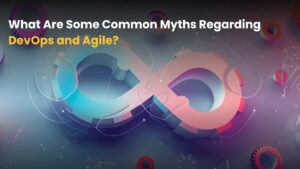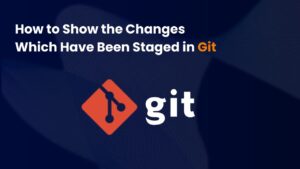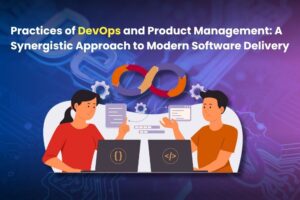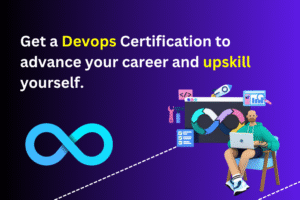DevOps, a fusion of “Development” and “Operations,” has rapidly become a vital practice in modern IT environments. DevOps improves cooperation, increases deployment frequency, lowers failure rates, and guarantees a quicker time-to-market for applications by bridging the gap between software development and IT operations. As businesses increasingly adopt DevOps principles, the demand for professionals proficient in DevOps tools and practices continues to rise.
What is a DevOps Program?
The notion that DevOps is not a single ability may be familiar to you when we discuss it as a discipline. Rather, it is a set of skills covering every facet of the software development process, from development to operations. To become a DevOps engineer, one must become proficient in more than 20 tools and have a thorough grasp of development, operations, and administration procedures.
It is challenging to accomplish this without a formal learning plan, which is why DevOps programs are in place. In addition to comprehensive training sessions, doubt-resolution sessions, and practical practice laboratories, they provide a well-organized curriculum. The challenging task of studying DevOps becomes relatively simple with all these capabilities and a guided learning path.
Best DevOps Program Subjects
A thorough DevOps course syllabus gives students the academic understanding and practical skills they need for real-world application. This article provides a fully detailed and professionally outlined syllabus overview, ideal for academic institutions, training providers, and self-learners aiming to design or pursue a well-rounded DevOps learning path.
1. Introduction to DevOps
Learning Objectives:
- Understand the origins, philosophy, and core principles of DevOps
- Grasp how DevOps differs from traditional IT models
- Explore the commercial benefits and effect of DevOps
Topics Covered:
- History and evolution of DevOps
- DevOps vs Agile, ITIL, and Waterfall
- CALMS (Culture, Automation, Lean, Measurement, Sharing) are important DevOps tenets.
- The DevOps lifecycle and value stream
Outcomes:
Learners will build a foundational understanding of DevOps culture, identify its business benefits, and comprehend its integration into modern IT workflows.
2. Software Development Lifecycle (SDLC) & Agile Methodologies
Learning Objectives:
- Relate DevOps practices to Agile, Lean, and traditional software development approaches
- Learn the iterative model that supports DevOps principles
Topics Covered:
- Software Development Lifecycle Phases
- Waterfall vs. Agile vs. DevOps
- Introduction to Scrum, Kanban, and SAFe frameworks
- Continuous feedback and iteration
Outcomes:
Participants will understand how Agile and Lean influence DevOps, and how cross-functional teams align their workflows for continuous delivery.
3. Version Control with Git
Learning Objectives:
- Develop your knowledge of Git source code management.
- Collaborate efficiently using Git-based platforms
Topics Covered:
- Introduction to Git: commands, repositories, and workflows
- Branching, merging, and resolving conflicts
- Git best practices (commit messages, rebase, stash)
- Overview of GitHub, GitLab, and Bitbucket
Practical Tools:
- Git CLI
- GitHub, GitLab, Bitbucket
Outcomes:
Learners will develop the skills to manage code repositories, collaborate in teams, and understand version control as the backbone of modern development.
To become an Expert in DevOps, check the DevOps Training in Pune Course.
4. Continuous Integration (CI)
Learning Objectives:
- Automate software development and testing
- Regularly incorporate code updates into common repositories
Topics Covered:
- Definition and significance of CI
- CI pipeline setup and management
- Build tools (Maven, Gradle, NPM)
- Unit testing and test automation (JUnit, PyTest)
- Integration with Git repositories
Practical Tools:
- Jenkins, GitHub Actions, GitLab CI/CD, CircleCI
- SonarQube for code quality analysis
Outcomes:
Students will learn how to create CI pipelines that compile, test, and validate code changes automatically with every commit.
5. Continuous Delivery and Deployment (CD)
Learning Objectives:
- Automate release processes for staging and production environments
- Understand deployment strategies and rollback mechanisms
Topics Covered:
- Difference between continuous delivery and continuous deployment
- Deployment patterns: blue-green, canary, rolling, and A/B testing
- Feature flagging and release automation
- Approval gates and change management
Practical Tools:
- Spinnaker, Argo CD, Octopus Deploy
- Helm for Kubernetes deployments
Outcomes:
Students will be capable of building delivery pipelines that push code safely and efficiently to production environments.
6. Infrastructure as Code (IaC)
Learning Objectives:
- Automate the provisioning and setup of infrastructure
- Manage and scale environments programmatically
Topics Covered:
- What is Infrastructure as Code?
- Declarative vs. imperative IaC models
- Cloud provisioning using Terraform and AWS CloudFormation
- Configuration management with Ansible, Chef, Puppet
Practical Tools:
- Terraform, AWS CloudFormation
- Ansible, Puppet, Chef
Outcomes:
Students will develop the ability to write and deploy infrastructure templates, enabling version-controlled, repeatable, and scalable deployments.
7. Containerization and Kubernetes Orchestration
Learning Objectives:
- Package and deploy applications in isolated, lightweight containers
- Organize containerized apps with orchestration tools.
Topics Covered:
- Introduction to containers and Docker architecture
- Creating Dockerfiles and managing images
- Docker Compose for apps with several containers
- Essentials of Kubernetes: Pods, Services, Deployments, ConfigMaps, and Secrets
- Kubernetes cluster administration and deployment strategies
Practical Tools:
- Docker, Docker Compose
- Kubernetes, Minikube, kubectl, Helm
Outcomes:
Learners will gain hands-on experience in containerization and orchestration, essential for building scalable and portable applications.
8. Cloud Platforms and DevOps
Learning Objectives:
- Use public cloud platforms to deploy and administer apps.
- Understand how cloud-native tools support DevOps
Topics Covered:
- An overview of the IaaS, PaaS, and SaaS cloud service models
- Cloud deployment architectures and best practices
- Working with AWS, Azure, and GCP
- CI/CD integrations in cloud environments
Practical Tools:
- AWS EC2, S3, EKS; Azure DevOps; Google Cloud Run, GKE
- Cloud CLI tools (AWS CLI, Azure CLI)
Outcomes:
Participants will be proficient in deploying applications to cloud environments and leveraging cloud-native DevOps services.
9. Monitoring, Logging, and Observability
Learning Objectives:
- Monitor application and infrastructure performance
- Detect issues proactively and respond to incidents efficiently
Topics Covered:
- Observability principles: metrics, logs, traces
- Log aggregation and visualization
- Setting up alerts and dashboards
- SLA, SLO, and SLI metrics for reliability
Practical Tools:
- Prometheus, Grafana
- ELK Stack (Elasticsearch, Logstash, Kibana), Fluentd
- Datadog, New Relic
Outcomes:
Learners will understand how to implement observability into systems to ensure availability, performance, and reliability.
10. DevSecOps – Security in DevOps
Learning Objectives:
- Integrate security procedures at every stage of the DevOps process.
- Automate vulnerability detection and compliance
Topics Covered:
- Introduction to DevSecOps
- Application security testing, including static and dynamic (SAST & DAST)
- Secret management and secure coding practices
- Open source dependency scanning
Practical Tools:
- Snyk, OWASP ZAP, Trivy
- HashiCorp Vault, Aqua Security
Outcomes:
Learners will understand how to embed security early in the development lifecycle, fostering a shift-left approach to application security.
11. DevOps Tools Integration & Automation
Learning Objectives:
- Integrate and automate workflows using DevOps toolchains
- Understand how various tools interact across the DevOps pipeline
Topics Covered:
- Tool integration patterns and challenges
- Automation using scripting languages (Bash, Python)
- DevOps-as-a-Service platforms
- Custom pipelines with webhooks and APIs
Outcomes:
Students will be adept at combining tools to build cohesive and efficient DevOps environments tailored to specific projects.
12. Capstone Project and Certification Preparation
Learning Objectives:
- Apply DevOps concepts in a real-world, end-to-end project
- Prepare for industry-recognized DevOps certifications
Topics Covered:
- Complete implementation of the CI/CD pipeline, including builds, testing, deployment, security, monitoring, and version control
- Project documentation and team collaboration
- Certification syllabus reviews: AWS Certified DevOps Engineer, Docker Certified Associate, CKA, etc.
- Interview preparation and job market guidance
Outcomes:
Learners will complete a portfolio-worthy project and gain confidence to pursue job opportunities and certifications in DevOps.
DevOps Topics in Detail
1. DevOps Fundamentals
What it Covers:
- Definition & Origins: How DevOps evolved from Agile and Lean
- Core Goals: Speed, collaboration, reliability, and automation
- DevOps Lifecycle: Plan → Develop → Build → Test → Release → Deploy → Operate → Monitor
CALMS Framework:
- Culture
- Automation
- Lean
- Measurement
- Sharing
Why It Matters:
The cornerstone of any effective adoption and execution is a thorough knowledge of DevOps culture and principles.
2. Agile and Lean Software Development
What it Covers:
- Agile methodologies (Scrum, Kanban)
- Iterative and incremental development
- Minimum Viable Product (MVP) philosophy
- Continuous feedback loops
Why It Matters:
DevOps extends Agile by automating everything from development through to operations—Agile is the launchpad.
3. Version Control with Git
What it Covers:
- Git basics: init, clone, commit, push, pull, merge
- Branching strategies: GitFlow, trunk-based development
- Pull requests, reviews, rebasing
- Platforms: GitHub, GitLab, Bitbucket
Why It Matters:
Git underpins collaboration, CI/CD pipelines, and traceability. It’s the most fundamental tool in any DevOps toolkit.
4. Continuous Integration (CI)
What it Covers:
- Jenkins, GitHub Actions, GitLab CI, and CircleCI are among the tools
- Used to automate code integration into a shared repository and
- Run tests automatically on each change.
- Development tools: NPM, Gradle, and Maven
Why It Matters:
CI shortens feedback cycles, enhances code quality, and lessens integration issues.
5. Continuous Delivery & Continuous Deployment (CD)
What it Covers:
- Releasing software in short cycles
- Automated deployment to staging or production
- Canary, blue-green, and rolling deployments
- Tools: Argo CD, Spinnaker, Octopus Deploy
Why It Matters:
CD lowers the danger and inconvenience of conventional releases by guaranteeing software may be reliably deployed at any time.
6. Infrastructure as Code (IaC)
What it Covers:
- Automating infrastructure provisioning
- Writing code to manage networks, servers, and services
- Tools: Terraform, AWS CloudFormation, Pulumi
- Configuration management: Ansible, Puppet, Chef
Why It Matters:
IaC enables consistent, scalable, and repeatable infrastructure setups, which is key to reliability.
7. Containerization with Docker
What it Covers:
- Packaging applications into containers
- Building Docker images using Dockerfiles
- Running containers and using Docker Compose
- Managing container registries (Docker Hub, private registries)
Why It Matters:
Containers guarantee constant environments, which solves the “it works on my machine” issue.
8. Container Orchestration with Kubernetes
What it Covers:
- Managing containers at scale
- Kubernetes components: pods, services, deployments, nodes
- Helm charts for app packaging
- Scaling, autoscaling, rolling updates
Why It Matters:
Kubernetes is the industry standard for managing production-grade containerized applications.
9. Cloud Platforms and DevOps Integration
What it Covers:
- Using AWS, Azure, or Google Cloud for infrastructure
- Cloud-native tools: GCP Cloud Build, Azure DevOps, and AWS CodePipeline
- Serverless deployments, container services, and managed databases
Why It Matters:
In DevOps operations, cloud services offer cost-effectiveness, scalability, and flexibility.
10. Monitoring, Logging, and Observability
What it Covers:
- Capturing metrics, logs, and traces
- Tools: Prometheus (metrics), Grafana (dashboards), ELK Stack (logs)
- Setting alerts and thresholds
- Real-time analysis for production health
Why It Matters:
You can’t improve what you can’t see. Observability is essential for uptime, performance, and customer experience.
Conclusion
A robust DevOps course syllabus balances foundational theory with intensive hands-on practice, providing learners with the tools, methodologies, and confidence to operate effectively in DevOps-centric organizations. By covering version control, CI/CD, containerization, cloud, infrastructure as code, monitoring, security, and collaboration practices, the curriculum ensures that graduates are well-prepared for the evolving IT landscape.
Whether you’re a developer transitioning into operations, a system admin shifting towards automation, or a fresher seeking a modern IT role, a structured DevOps learning path is an investment in a future-ready skill set.
